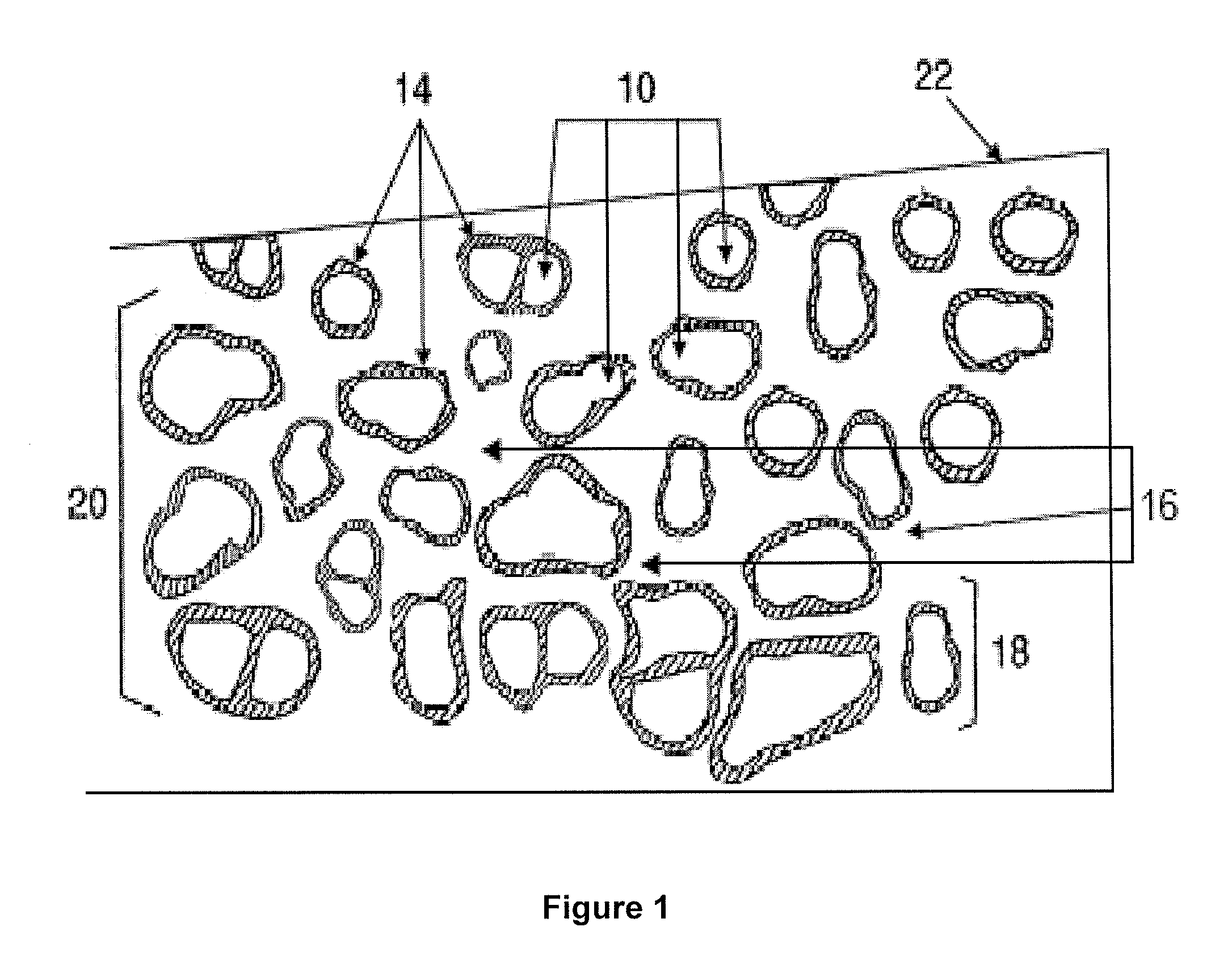Tough coated hard particles consolidated in a tough matrix material
a technology of hard particles and matrix materials, applied in the field of consolidated materials, can solve the problems of onset of permanent yielding, limiting useful strength, and creating high strength that is not controlled, and achieves the effects of improving transverse rupture strength, reducing the number of sinterings, and maintaining or improving the hardness or other desired properties of conventional sintering tchp materials
- Summary
- Abstract
- Description
- Claims
- Application Information
AI Technical Summary
Benefits of technology
Problems solved by technology
Method used
Image
Examples
example 1
Typical Powder Preparation Procedure
[0107]The following is a non limiting example of a powder preparation procedure that was used to prepare a powder in accordance with the present disclosure on a small lab scale basis.
[0108]Using a milling container, the proper proportions of TCHP powder and WC—Co matrix powder were weighed. Generally, the total weight of the powders was about 800 g. Thus, to obtain a powder mixture comprising 25 weight % TCHP and 75 weight % matrix, about 200 g of TCHP and about 600 g of WC—Co matrix powder were used. In some instances, the raw material WC—Co matrix powder contained a small amount (˜2% by weight) of paraffin wax.
[0109]If a waxed powder was desired, an additional 2% of paraffin wax was added to the powder mixture, based on the weight of the TCHP particles. Conversely, if an unwaxed powder was desired, no paraffin wax (beyond the amount present in the raw material powders) was added to the mixture.
[0110]WC—Co milling balls in an amount corresponding...
example 2
Typical Drying Procedure
[0114]The following is a non limiting example of a typical drying procedure for a milled solution of TCHP / WC—Co powder prepared according to Example 1.
[0115]A milled solution of TCHP / WC—Co powder was decanted through a large sized sieve into a temperature resistant vessel (e.g., glass). The milling container used to produce the powder was rinsed with the corresponding solvent (e.g., heptane or ethanol) to remove any remaining milled solution from the WC—Co milling balls.
[0116]The temperature resistant vessel was then placed in a drying oven at a temperature of about 85° C. under a constant nitrogen flow, e.g., of about 2-3 SCFH. The powder was dried for a desired time, e.g., at least 12 hours.
[0117]The powder typically caked together during the drying process. To determine whether the powder was dry, a spatula was used to break apart some of the caked powder. The powder was considered sufficiently dry when the caked powder broke apart into a fine powder.
[0118...
example 3
A First Typical Consolidation Procedure
[0120]The following is a non limiting example of a typical procedure used to produce consolidated articles of the present disclosure via uniaxial hot pressing.
[0121]A mixed, but unwaxed powder including a mixture of TCHP and WC—Co powder was placed into a graphite die set. The die set containing the mixed powder was loaded into the master die of a hot press. The top ram of the hot press was lowered until it came into contact with the top of the die set. The chamber door of the hot press was then closed, and the chamber was evacuated to a minimum pressure of 5.0×10−3 torr.
[0122]The hot press was programmed to perform a typical heating cycle, and then switched to automatic control. The mixed powder was then pressed at a specified temperature, at a specified ram pressure, for a specified hold time. The standard parameters used were a temperature of about 1400° C., a pressure of 15 MPa, and a hold time of 100 minutes, although other parameters have...
PUM
| Property | Measurement | Unit |
|---|---|---|
| Fraction | aaaaa | aaaaa |
| Fraction | aaaaa | aaaaa |
| Time | aaaaa | aaaaa |
Abstract
Description
Claims
Application Information
 Login to View More
Login to View More - R&D
- Intellectual Property
- Life Sciences
- Materials
- Tech Scout
- Unparalleled Data Quality
- Higher Quality Content
- 60% Fewer Hallucinations
Browse by: Latest US Patents, China's latest patents, Technical Efficacy Thesaurus, Application Domain, Technology Topic, Popular Technical Reports.
© 2025 PatSnap. All rights reserved.Legal|Privacy policy|Modern Slavery Act Transparency Statement|Sitemap|About US| Contact US: help@patsnap.com



